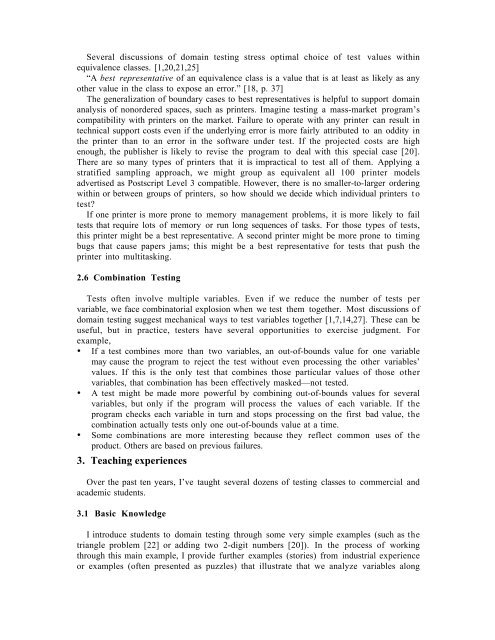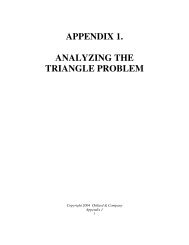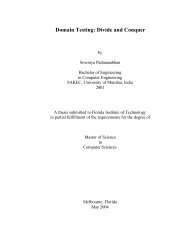Teaching Domain Testing: A Status Report - Testing Education
Teaching Domain Testing: A Status Report - Testing Education
Teaching Domain Testing: A Status Report - Testing Education
Create successful ePaper yourself
Turn your PDF publications into a flip-book with our unique Google optimized e-Paper software.
Several discussions of domain testing stress optimal choice of test values within<br />
equivalence classes. [1,20,21,25]<br />
“A best representative of an equivalence class is a value that is at least as likely as any<br />
other value in the class to expose an error.” [18, p. 37]<br />
The generalization of boundary cases to best representatives is helpful to support domain<br />
analysis of nonordered spaces, such as printers. Imagine testing a mass-market program’s<br />
compatibility with printers on the market. Failure to operate with any printer can result in<br />
technical support costs even if the underlying error is more fairly attributed to an oddity in<br />
the printer than to an error in the software under test. If the projected costs are high<br />
enough, the publisher is likely to revise the program to deal with this special case [20].<br />
There are so many types of printers that it is impractical to test all of them. Applying a<br />
stratified sampling approach, we might group as equivalent all 100 printer models<br />
advertised as Postscript Level 3 compatible. However, there is no smaller-to-larger ordering<br />
within or between groups of printers, so how should we decide which individual printers to<br />
test?<br />
If one printer is more prone to memory management problems, it is more likely to fail<br />
tests that require lots of memory or run long sequences of tasks. For those types of tests,<br />
this printer might be a best representative. A second printer might be more prone to timing<br />
bugs that cause papers jams; this might be a best representative for tests that push the<br />
printer into multitasking.<br />
2.6 Combination <strong>Testing</strong><br />
Tests often involve multiple variables. Even if we reduce the number of tests per<br />
variable, we face combinatorial explosion when we test them together. Most discussions of<br />
domain testing suggest mechanical ways to test variables together [1,7,14,27]. These can be<br />
useful, but in practice, testers have several opportunities to exercise judgment. For<br />
example,<br />
• If a test combines more than two variables, an out-of-bounds value for one variable<br />
may cause the program to reject the test without even processing the other variables’<br />
values. If this is the only test that combines those particular values of those other<br />
variables, that combination has been effectively masked—not tested.<br />
• A test might be made more powerful by combining out-of-bounds values for several<br />
variables, but only if the program will process the values of each variable. If the<br />
program checks each variable in turn and stops processing on the first bad value, the<br />
combination actually tests only one out-of-bounds value at a time.<br />
• Some combinations are more interesting because they reflect common uses of the<br />
product. Others are based on previous failures.<br />
3. <strong>Teaching</strong> experiences<br />
Over the past ten years, I’ve taught several dozens of testing classes to commercial and<br />
academic students.<br />
3.1 Basic Knowledge<br />
I introduce students to domain testing through some very simple examples (such as the<br />
triangle problem [22] or adding two 2-digit numbers [20]). In the process of working<br />
through this main example, I provide further examples (stories) from industrial experience<br />
or examples (often presented as puzzles) that illustrate that we analyze variables along








